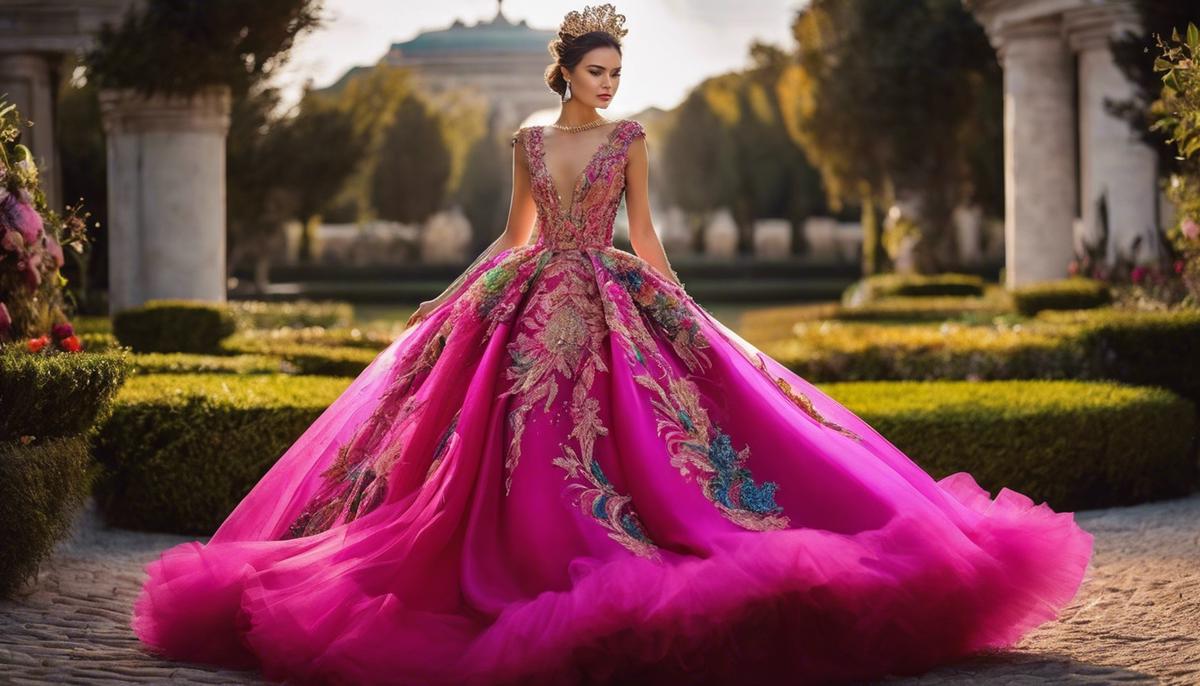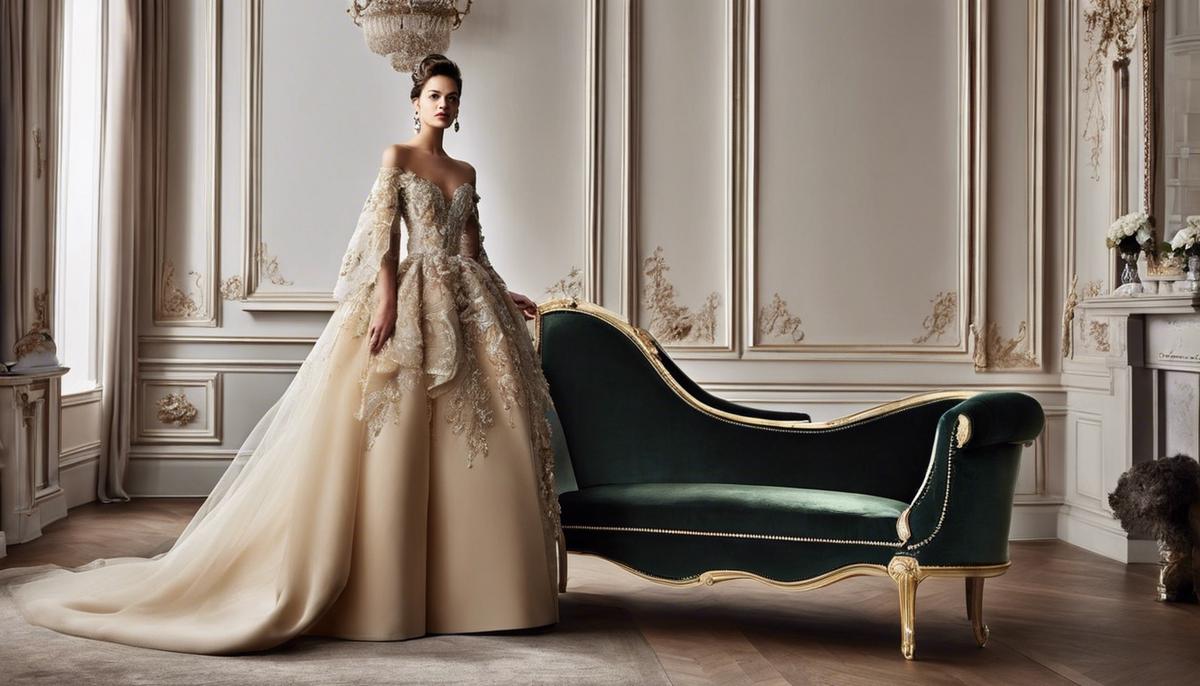Set amidst a realm of luxury, opulence, and painstaking handiwork, haute couture represents the pinnacle of fashion. Esteemed for its exclusivity and grandeur, this sector of the fashion industry carves out an economic niche that marries profitability with supreme distinction. To understand the complexities of haute couture’s economic fabric, we must delve into a panoply of interwoven factors. These include its immutable principles, the delicate balance it strikes between exclusivity and profitability, the immense role of branding, and the pursuit of sustainable profitability. Further exploration into current trends and innovations provides a broader understanding of how haute couture adapts to an ever-changing economic and social landscape.
The Principles of Haute Couture
Unveiling the Elite World of Haute Couture: How Interior Economics Shape a Niche Industry
Prestige, opulence, and meticulous craftsmanship, synonymous with the haute couture industry, are not just facets of mere fashion. These attributes are impressive metrics of economic competence. The fundamentals of haute couture, from niche market penetration to high-end production, offer profound insights into economics.
Setting the tone, it’s worth appraising what haute couture actually means. Originating in 19th century Paris, the term haute couture means “high sewing”. It refers to a secretive realm of fashion where garments are entirely hand-crafted for exclusive clientele. Given this exclusivity, the industry thrives on individuality, ensuring products unduplicated, nudging the industry into the realm of luxury goods economics.
Connection between scarcity and prestige in haute couture aligns seamlessly with the basic economic theory of supply and demand. High-quality materials combined with the time and skill invested produce scarce goods. As a result, demand soars, price escalates, and the value of the product, both in financial and status terms, increases. This posh scarcity lends haute couture a unique appeal and dictates the undulating economics of the industry.
Perhaps, no economic concept is as glaringly relevant to this sector as labor theory of value. This theory stipulates that value of a product is directly correlated to the labor invested in it. A typical haute couture gown demands hundreds, sometimes thousands, of labor hours. This includes sketching, draping, patterning, cutting, sewing, and embellishing, transforming raw materials into a garment worthy of a gala or a red-carpet event. Hence, the astronomical prices commanded by haute couture pieces can be better comprehended when viewed through the lens of labor theory.
One intriguing aspect here is the price elasticity of demand. With an elite client base that is relatively insensitive to price, the demand is inelastic. This allows fashion houses to enjoy high margins and financial safety even during economic volatility.
Interestingly, a strong professional network and partnerships hold significant importance in the haute couture industry, much like in any business. While fashion houses helm the creative aspect, myriad external craftsmen, often categorized as ‘Little Hands’ or ‘Les Petites Mains’ in French, provide the intricate detailing that these garments deserve. This network strengthens the fashion ecosystem.
In conclusion, the fabric of haute couture, woven with detailed craftsmanship and opulence, offers valuable economic insights. Although an elite sector, the industry’s fundamentals reverberate in other markets, emphasizing the eternal relevance of principles like supply, demand, and value. As the allure of haute couture transcends its artistic prowess, the potent marriage of fashion and economics becomes apparent, underscoring the cyclical rhythm where business and creativity intersect. Indeed, even in a niche realm like haute couture, economics remains an omnipresent stitch.

The Balance of Exclusivity and Profitability
Rolling out the Red Carpet: Luxury, Exclusivity and Haute Couture
Navigating the treacherous waters of the haute couture fashion market is no small feat for luxury fashion brands. These brands deftly walk the tightrope that swings between exclusivity and profitability. Not only do they cater to a highly specialized consumer segment, but they also ensure that these consumers are constantly enticed by their cutting-edge designs, while maintaining an unerring profitability margin that steers clear of mass market transmission.
Let’s unravel the conundrum of balancing exclusivity and profitability that these luxury fashion brands face in the haute couture market.
Creating Demand through Limited Availability
Limited availability is a ground-breaking stratagem that adds to a product’s desirability. Unlike other sectors, where large volumes of production translate into higher profitability, fashion luxury brands suppress volumes to ramp up demand. This tactic ensures the brand’s exclusivity remains intact, while profitably capitalizing on the frenzy generated by deliberately undersupplying to a saturated demand market.
Crafting a Perceptive Brand Image
The psychology driving luxury consumption is quite fascinating. A branded product elicits feelings of prestige, quality, and superiority. Luxury brands leverage this to their advantage by cultivating a brand image that oozes exclusivity. The consumer’s perception that they belong to a privileged club that can afford these luxuries is a powerful motivator for purchase. This psychological tug of war contributes significantly to the profitability of luxury fashion brands.
Harnessing the Power of Digitalization
In an age where technology has reshaped traditional market spaces, the haute couture industry isn’t left unscathed. Fashion houses are increasingly turning to tech-savvy marketing endeavors, using high-res videos and immersive digital arts to lure the upper echelons. These innovative marketing strategies enable brands to control the narrative surrounding their products’ exclusivity, paving the way for formidable retail profits.
Insulating Against Market Volatility
The luxury fashion market is susceptible to the volatility of economic indicators and potentially turbulent marketplaces such as China and Russia. Maintaining exclusivity in this landscape necessitates elegant tactical plays, including a keen understanding of the law of supply and demand, currency hedging, and startlingly accurate predictions of future economic patterns. These strategies help luxury fashion brands ensure consistent profitability while fighting market volatility to maintain exclusive status.
Meticulous Positioning of Product Lines
Luxury brands masterfully cater to various consumer classes without diluting their exclusive image. This achieved by introducing multiple product lines, each positioned uniquely to appeal to a specific consumer class while maintaining profitability. Such ‘masstige’ lines balance exclusivity and profitability by attracting a broader spending category that values the association with a prestigious brand.
The haute couture market is in a continual state of flux, with the scales of exclusivity and profitability perpetually back and forth. For luxury fashion brands, striking the right balance is tantamount to conducting a masterful symphony, captivating their discerning audience with every precise note.

The Role of Branding in Luxury Fashion
The Power of Branding in the Swift Currents of the Haute Couture Market
There is no disregarding the intense impact branding wields in the economics of the haute couture industry. It goes much deeper than embroidered logos and ostentatious motifs; instead, it infiltrates the core psychology of consumers and the market landscape. Actively shaping consumer perceptions, branding in haute couture is less about a product and more about an experience, a promise of lifestyle, artistry, and sophistication.
Branding in haute couture operates subtly yet effectually; it persuades clients to perceive clothing not merely as fabric stitched together but as a work of art. Each garment is painstakingly crafted often with thousands of hand-sewn details. The reputation of a couture fashion house lies not just in delivering clothes, but a narrative steeped in tradition, craftsmanship, creativity, and exclusivity. Through well-nurtured branding, these narratives charge a hefty premium that the elite clientele willingly pays for the allure of exclusivity.
In a realm where limited availability stokes desire, a brand’s fundamental strength lies in its image and perception. Consumers don’t just buy couture designs; they invest in a brand’s vision and the once-in-a-lifetime experience it offers. Reinforcing their exclusivity through the precisely orchestrated rarity of these products further bolsters their value, supporting the adage, “scarcity breeds desire.”
Advanced technology and digitalization play an essential role in haute couture branding in the modern age. We are in an era where millennials and Gen Z influence markets, fueling a shift in marketing strategies in couture houses. Embracing digital platforms can expand brand visibility, usher in a broader audience and fortify brand messages. Use of dynamic presentations, virtual reality experiences and live-streaming of fashion shows help in crafting the virtual narrative of a brand on a global scale, upholding the coveted exclusivity yet meeting the modern consumer’s expectations.
In tandem with the campaign towards embracing newer customer segments, there is a meticulous positioning of product lines in the market, a closely watched balancing act. Each product line caters to its unique set of clientele: diffusion lines to the budget-conscious, ready-to-wear lines to the realistic, and haute couture to the affluent. This approach allows couture brands to cast a wider net while still upholding their luxury ethos.
Strategizing for market instability and economic fluctuations is another fascinating aspect of haute couture branding. Resilience is built by fostering relationships with a select clientele, often offering personalized treatment. Furthermore, diversification into other lucrative sectors like perfumes, accessories, and cosmetics increases revenue streams, mitigating risks from an unpredictable haute couture market.
In the final analysis, it’s clear that to navigate through the complex haute couture industry requires stellar branding. The balance of maintaining captivating exclusivity alongside sustained profitability is a thrilling challenge. From a bird’s eye view, branding’s role transcends selling clothes; it crafts an ecosystem where artistry, economics, and desire coalesce into a successful business model. In the haute couture universe, the power of branding reigns supreme.

How Does Fashion Week Impact the Economic Balance of Luxury Brands?
The fashion week cost couture impact on luxury brands is significant. Participating in fashion week events can elevate a brand’s status, leading to increased sales and brand loyalty. However, the substantial financial investment in producing and showcasing collections can unbalance the economic scale for some luxury brands.
Sustainable Profitability in Haute Couture
Consistent innovation and captivating storytelling and a solid distribution strategy further reinforce the success of haute couture houses. Reinventing oneself while preserving the essence of a brand is a significant contributing factor in the permanence of these high-end fashion houses. Mutating trends do not intimidate them. Quite the contrary, they foresee trends and incorporate them in strategic presentations that capture the imagination of their select clientele. The result? A customer emotionally invested in the story and eager to participate in it, making each creation, a walk-in artwork that commands top dollar.
Haute couture thrives on relationships. Building and maintaining relationships is paramount in a market that caters to the elite. These relationships aren’t limited to clients alone but extend to celebrities, influencers, and media houses. The power of the third party endorsement in this sector cannot be overlooked. The association with influential figures not only enhances a brand’s prestige but vastly extends its reach.
Technology has permeated every industry, and haute couture is not exempt. Advanced technology isn’t only applied in marketing but also manufacturing. The integration of digital solutions into the production process bridges the gap between craftsmanship and efficiency. Techniques like laser cutting and 3d printing allow for precision and detailed work but within reduced timeframes, which contributes vastly to revenue optimization and profitability.
Vertical integration proves another strategic driver behind sustainable profitability. By controlling the chain’s entirety, from textile production to retail, haute couture houses reduce their dependency on third-party suppliers, trimming costs and increasing revenue margins.
Furthermore, venturing into profitable extensions such as perfume, makeup, and accessories, serves to maintain brand relevance and simultaneously open additional revenue streams. Such product extensions, while more accessible to the masses, serve to carefully democratize the brand while maintaining its exclusivity.
Lastly, product presentation serves as an important tool in sustaining profitability. Haute couture spectacles are not simply fashion shows, they are well-curated performances designed to showcase the grandeur of the brand, fueling desire and securing customer loyalty.
In conclusion, while the market for haute couture is selective, it is, however, not confined to the catwalks of Paris, Milan, London, and New York. Through calculated ingenuity, constant reinvention, carefully curated expansions, and the clever use of technology, the haute couture industry continually proves that the essence of luxury lies in the timeless art of tailoring experiences as much as garments.

Innovation and Trends Shaping Haute Couture
The rich tapestry of haute couture offers numerous instances of consistent innovation and captivating storytelling. Businesses maneuver in this niche sector by constantly reinventing themselves. Yet, they maintain the essence of their brand, a delicate balance that takes nuance and strategy.
Incorporating trends in product presentations becomes an invaluable technique, creating an ever-evolving narrative that entices elite clientele. This dynamism is inherent to the art of haute couture, where the aim is to blend traditional craftsmanship with cutting-edge designs and fresh ideas.
Relationships are another cornerstone in haute couture. By nurturing connections with clients, celebrities, influencers, and media houses, haute couture establishments manage to maintain high visibility and desirability. Third-party endorsements, in particular, serve as a powerful tool in fortifying brand reputation and its reflected prestige.
The integration of advanced technology is another trend making substantial waves. From marketing strategies that employ digital platforms for greater customer reach, to the manufacturing process where techniques like 3D printing align with traditional sewing methods, technology’s prevalence can’t be underestimated.
A strategic step often adopted by haute couture houses is vertical integration. It’s a move designed to enhance control over supply and manufacturing processes, boost revenue margins, and mitigate the costs inherent to producing one-of-a-kind pieces.
In this vein, many haute couture brands capitalize on their high-profile image by venturing into profitable extensions, such as perfume, makeup, and accessories. These additional offerings not only boost revenue but also expand the brand’s appeal to a wider customer base.
Rather than merely focusing on clothing, many houses recognize the power of presentation. From stores in high-profile locations to exclusive, invite-only fashion shows, the presentation is as much a part of the product as the garment itself.
While haute couture was once mostly confined to select fashion capitals like Paris and Milan, today’s industry is much more diverse. Emerging designers from various geographical locales are making their mark and gaining recognition on par with established brands, demonstrating the industry isn’t as exclusive as it once was.
In essence, the economics of haute couture transcends mere garment manufacturing. It’s an intricate ballet of innovation, strategic networking, brand expansion, and careful market positioning. The industry’s ability to reform, yet sustain its essence, constitutes the art, allure, and persistent relevance of haute couture. With these strategies in play, the industry is well-equipped to face future challenges and capitalize on emerging opportunities.

Reflecting upon the economic dynamics behind the shimmering veil of haut couture, it becomes apparent how intricate strategies and deep-seated principles form the backbone of this luxurious world. Navigating the tightrope between exclusivity and profitability, leveraging branding power, fostering sustainable profitability, and staying ahead with innovations and trends are the key to ensuring longevity in this industry. As the momentum of change powers forward, so does haute couture; continuously evolving, yet always staying true to the essence of luxury. The haute couture industry, just like a beautifully tailored piece, is a much thought-out, delicate balance between palettes of traditions and patterns of innovation.










